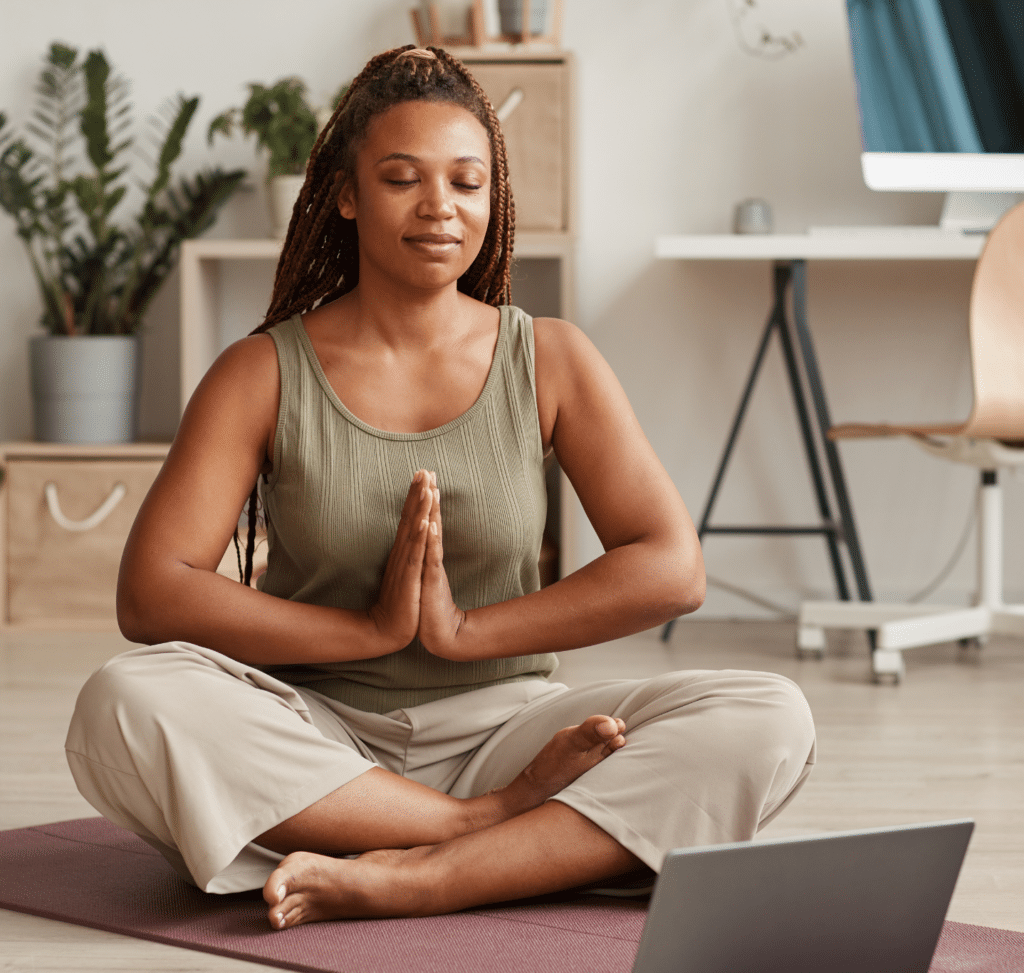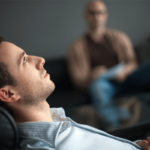31 Grounding Techniques for Anxiety and Panic Attacks

Have you ever felt your anxiety overtaking your body? In the throes of a panic attack or on really bad days, anxiety can feel like a never-ending rollercoaster of emotions and scary physical symptoms. If you’re one of many adults (over 40 million, in fact) struggling with anxiety, you might be wondering, “How can I get a handle on my anxiety?” You may also be asking which grounding exercises work for you.1
Fortunately, there are plenty of techniques for managing anxiety you can use when you’re feeling overwhelmed. We’ve put together a list of 31 proven and effective grounding techniques that can help you manage your anxiety and regain control over your thoughts and emotions.
These grounding techniques for anxiety can help you feel more stable, settle your nerves, and reduce your anxiety, so you can start living life without being consumed by fear.

Why It’s Important to Manage Anxiety and Panic Attacks
An estimated 11% of people in the US will suffer from a panic attack every year. Yet another 2-3% also experience panic disorder.2 For these people, panic attacks are more than just a scary, one-off event.
Panic disorder causes people to live in constant fear of another panic attack. This fear then leads to a cycle of worry and more panic attacks, which can be hard to stop. Living with untreated panic disorder can have a significant impact on a person’s physical and emotional well-being. It can increase a person’s risk of:3
- Coronary artery disease
- Increased risk of sudden death
- Suicidality, suicidal thoughts, and self-harm
- Social, occupational, and physical disability
That’s why early support and effective coping strategies are so important. You deserve to feel safe and secure and have coping skills at your disposal in case of an anxiety attack. These 31 anxiety relief grounding methods may not only help bring you back from a panic attack but also give you a sense of control and empowerment over your anxiety.
31 Grounding Techniques for Managing Anxiety
1. Breathing Exercises
2. Grounding Objects
3. Progressive Muscle Relaxation
4. Body Scan
Similar to PMR, body scans can also help you recognize areas of the body that are tense and also acknowledge symptoms of anxiety. How does your chest feel? Is it tight? Is your breathing fast or slow? By acknowledging these sensations without judgment, you can begin to form a stronger mind/body connection and shift your anxious thoughts away and back to reality.
5. Meditation
Mindfulness-based stress reduction, or MBSR, is a type of meditation that teaches you to gently accept thoughts and feelings, even when anxious, while being fully present in the moment. This can be helpful for managing anxiety because it allows you to observe your anxious thoughts without getting caught up in them. Research shows that MBSR and meditation can help reduce overall anxiety.7
6. Exercise
Yet another amazing technique for reducing anxiety with grounding is through exercise. Research shows that aerobic exercise and yoga can help calm anxious states.8 It’s important to do moderate or high-intensity exercise to get the most benefits, like taking a run or a brisk walk.
7. Engaging the Senses
Besides grounding objects, there are other ways to do the 5-4-3-2-1 technique. You can engage your senses by noticing and naming things that you see, hear, touch, smell, or taste around you. Engaging all five of your senses is one of the best quick grounding techniques you can do from absolutely anywhere you are!
8. Cuddling Your Pet
Did you know that spending time with your dog can increase mood and reduce anxiety?9 In the midst of a panic attack, even something as simple as cuddling your pet, feeling their soft fur, and using them as a source of comfort can help ground you.
9. Stretching
Stretching is yet another great way to release tension and calm your nerves. Whether you’re stretching during yoga or are simply doing a few simple stretches on your own, focusing on your body and how it feels can help bring you back to the present moment.
10. Go To a Safe Place
People with anxiety, especially post-traumatic stress disorder (PTSD), often struggle with feeling safe even after the trauma is over. If you’re experiencing a flashback or trigger for your PTSD, it’s okay to visit a safe place. This can be an area at home, in your car, or even under your blankets. While you’ll eventually need exposure and trauma therapy for long-term recovery, having a safe place with dim lights, music, or comfy furniture can be just what you need to get through intense flashbacks and anxiety.10
11. Self-Massage
Anxiety management with grounding can also involve pampering yourself with a relaxing massage. Studies have shown that massage therapy can decrease anxiety and stress levels.11 Whether you use lotion, oil, or just your hands, massaging your neck, shoulders, scalp, and feet can provide a sense of calm and comfort.
12. Writing in a Journal
Writing in a journal can be one of the most effective mental health grounding techniques. Jot down your emotions, do a stream of consciousness, or even rip up the paper when you’re done. This release is incredibly valuable for people experiencing anxiety.
There are many forms journaling can take, from the classic brain dump approach to the daily anchor of gratitude journaling. To find out more about the different types of journaling, and how to get involved, check out our page: Journaling for Mental Health.
13. Listening to Music
Music is yet another way to distract yourself from ruminating thoughts. Research shows that people who distract themselves have lower levels of depression and anxiety in the long run.12 While you don’t want to shove your anxious feelings completely away, a healthy level of distraction by listening to music can be beneficial.
14. Counting Objects in the Room
Counting objects is a great way to combine both distraction and grounding techniques. You can even go as far as sorting objects by color in your room or your surroundings for more anxiety relief.
15. Use a Cold Compress or Ice
Emerging research suggests that placing ice on the neck can actually help lower heart rate and stress.13 But, if this is too uncomfortable, even placing an ice cube on your hand can be one of the most accessible and fast grounding exercises at home. The cold sensation can help ground you during anxiety.
16. Reach Out to a Friend
Another great way to help pull you back to the present moment during anxiety is by reaching out to a friend. This can be through talking on the phone, texting, or even better, through a calming hug. No matter how small, interaction and support are vital during anxiety recovery.
17. Sort Things into Categories
Whether you want to visualize rearranging your spice rack, sorting your kids’ toys, or organizing your work documents, sorting things in categories can help give your mind something to focus on. The act of organization and creating order can be calming and satisfying, providing relief during anxiety.
18. Take a Walk Outside
We know that exercise can help treat anxiety, and even a brisk walk or small bike ride can be enough to provide relief.14 Using grounding to reduce stress can help before big events, during a panic attack, or for chronic anxiety. Next time you’re feeling overwhelmed, step outside for a walk in nature.
19. Use Scents to Ground Yourself
From aromatherapy to sniffing a candle or food nearby, there are plenty of ways you can activate your sense of smell. It can be tough to remember that your sense of smell plays an important role in grounding, especially in the middle of a panic attack. Try to ground yourself by using scents, even if it’s just a deep inhale at home.
20. Take a Bath or Shower
Baths or calming showers are a self-care haven. Don’t just mindlessly bathe. Instead, truly feel the temperature of the water on your skin, inhale the steam, and appreciate the sensation of water. All of these elements help ground you and allow you to have some time to decompress.
21. Eat Mindfully
Taste is yet another one of your senses you can consciously tap into during anxiety or a panic attack. Eating can be a mindful, hands-on experience, so take the time to taste each bite and notice the textures and flavors in your food. This helps bring your focus back to the present moment.
22. Distract Yourself With Funny Videos
Laughter has been shown to uplift mood, reduce stress, and even improve pain tolerance.15 Using grounding to reduce stress can be as simple as distracting yourself with funny videos or even finding humor around you.
23. Visualize a Getaway
Similar to escaping to a safe space when you’re having flashbacks or triggers, you can just as easily create a safe space in your mind. Using guided visual imagery, meditation, or just creating a peaceful scene in your head can help reduce anxiety.
24. Continue Planning the Day
A panic attack or bad anxiety can put a damper on your day. In these instances, fear has a way of taking over. But you can counteract this – don’t be afraid to continue to plan your day after and even during a panic attack. Even planning for the next 10 minutes can be empowering and a reminder that you are safe, physically and mentally.
25. Use a Weighted Blanket
Research shows that using a weighted blanket can help reduce anxiety symptoms.16 If you’re having night-time anxiety or just feeling a bit on edge, try wrapping yourself up in a weighted blanket. The pressure and weight can have a calming effect and help you feel more grounded.
26. Use a Fidget Toy
Fidget toys can be a great way to distract yourself and engage your touch senses. Using a fidget toy is one of the newest grounding strategies mental health experts are still in the process of studying. But, there’s no doubt using a fidget toy can provide a healthy distraction and give you something else to focus on during a panic attack.
27. Reduce Sensory Overload
People with sensory over-response, meaning they are easily overwhelmed by sensory input, can be more at risk of anxiety.17 Reducing sensory overload by going to a quiet place, wearing noise-cancellation earphones, or even turning down sounds like your kitchen vent can all help reduce anxiety.
28. Practice Acceptance of Feelings
Radical acceptance involves accepting your feelings without trying to change or control them. Instead of telling yourself, “Don’t be anxious,” try saying “It’s okay to feel anxious right now.” This acceptance is the first step in moving past anxiety and finding ways to cope with it.
29. Capture Your Surroundings
Photography, drawing, painting, or sketching can be a therapeutic way to capture and process your surroundings. This can help you see things in a different light, focus on the present moment, and express yourself creatively.
30. Play With Your Children (or Nieces and Nephews!)
Playing with your children or family is another way you can experience laughter, support, and exercise all at once. This is one of the best grounding exercises at home to both reduce stress and improve your mood.
31. Sing a Song
Panic Attack Grounding Techniques
Unfortunately, when panic attacks take hold, they can be difficult to stop on the spot, and most last between 5 to 20 minutes.19 During these attacks, minutes can feel like hours, and the fear, physical sensations, and feelings of going crazy can be overwhelming. During these times, it’s important to focus on specific grounding techniques for panic attacks that focus on stimulating the vagus nerve.
The vagus nerve is responsible for calming the sympathetic nervous system, which is what activates the “fight or flight” response during a panic attack. By stimulating this nerve, we can help slow down our body’s stress response and begin to relax. Stimulating this nerve has been shown to help improve anxiety and PTSD.20
There are several techniques listed above that can stimulate the vagus nerve.21 These include:
- Belly breathing
- Meditation
- Exercising
- Using ice
- Getting a massage
- Engage in awe-inspiring activities like nature walks
These panic attack grounding techniques are just the beginning of what you can do to start healing from anxiety and panic disorder. Research shows that in addition to grounding techniques, the best way to heal long-term from panic disorder is through cognitive-behavioral therapy (also known as CBT).22
During CBT, you can learn to use healthy thoughts and behaviors to reduce anxiety. Things like identifying misinterpreted feelings, being educated about panic attacks, exposure to triggers, and relaxation can all help you recover.
Reach Out for Support With Anxiety and Panic Attacks
At Mission Connection, we see how hard it can be to live with an anxiety disorder, chronic stress, and panic disorder. That’s why our goal is to help you manage your mental health problems with a wide range of therapies and approaches.
We offer both in-person at our treatment facilities and online therapy including CBT, exposure therapy for anxiety, outpatient and partial hospitalization treatment, and more. You don’t have to suffer in silence with your anxiety.
Call us today at 866-619-3844 to schedule a consultation and start the journey of healing from anxiety for good.

References
- National Alliance on Mental Illness. (2025, January 3). Anxiety disorders | NAMI. NAMI. https://www.nami.org/about-mental-illness/mental-health-conditions/anxiety-disorders/
- Cleveland Clinic. (2025, March 19). Panic attacks & panic disorder. https://my.clevelandclinic.org/health/diseases/4451-panic-attack-panic-disorder
- Cackovic, C., Nazir, S., & Marwaha, R. (2023, August 6). Panic disorder. StatPearls – NCBI Bookshelf. https://www.ncbi.nlm.nih.gov/books/NBK430973/
- Aktaş, G. K., & İlgin, V. E. (2022). The effect of deep breathing exercise and 4–7-8 breathing techniques applied to patients after bariatric surgery on anxiety and quality of life. Obesity Surgery, 33(3), 920–929. https://doi.org/10.1007/s11695-022-06405-1
- Psychological & Counseling Services. (2023, February 14). What is grounding. https://www.unh.edu/pacs/what-grounding
- U.S. Department of Veterans Affairs. (n.d.). Progressive muscle relaxation. https://www.va.gov/WHOLEHEALTHLIBRARY/tools/progressive-muscle-relaxation.asp
- Hoge, E. A., Bui, E., Marques, L., Metcalf, C. A., Morris, L. K., Robinaugh, D. J., Worthington, J. J., Pollack, M. H., & Simon, N. M. (2013). Randomized controlled trial of mindfulness meditation for generalized anxiety disorder. The Journal of Clinical Psychiatry, 74(8), 786–792. https://doi.org/10.4088/jcp.12m08083
- Lin, Y., & Gao, W. (2023). The effects of physical exercise on anxiety symptoms of college students: A meta-analysis. Frontiers in Psychology, 14, 1136900. https://doi.org/10.3389/fpsyg.2023.1136900
- PTSD UK. (n.d.). Understanding PTSD flashbacks and triggers. https://www.ptsduk.org/what-is-ptsd/understanding-ptsd-flashbacks-and-triggers/
- Palmer, C. (2024, January 1). In brief: Pets can help reduce anxiety, boredom during tests negatively impacts results, and more research. APA.org. https://www.apa.org/monitor/2024/01/pets-reduce-anxiety
- Sherman, K. J., Ludman, E. J., Cook, A. J., Hawkes, R. J., Roy-Byrne, P. P., Bentley, S., Brooks, M. Z., & Cherkin, D. C. (2010). Effectiveness of therapeutic massage for generalized anxiety disorder: A randomized controlled trial. Depression and Anxiety, 27(5), 441–450. https://doi.org/10.1002/da.20671
- Roelofs, J., Rood, L., Meesters, C., Dorsthorst, V. T., Bögels, S., Alloy, L. B., & Nolen-Hoeksema, S. (2009). The influence of rumination and distraction on depressed and anxious mood: A prospective examination of the response styles theory in children and adolescents. European Child & Adolescent Psychiatry, 18(10), 635–642. https://doi.org/10.1007/s00787-009-0026-7
- Jungmann, M., Vencatachellum, S., Van Ryckeghem, D., & Vögele, C. (2018). Effects of cold stimulation on cardiac-vagal activation in healthy participants: Randomized controlled trial. JMIR Formative Research, 2(2), e10257. https://doi.org/10.2196/10257
- Ratey, J. J. (2019, October 24). Can exercise help treat anxiety? Harvard Health. https://www.health.harvard.edu/blog/can-exercise-help-treat-anxiety-2019102418096
- Akimbekov, N. S., & Razzaque, M. S. (2021). Laughter therapy: A humor-induced hormonal intervention to reduce stress and anxiety. Current Research in Physiology, 4, 135–138. https://doi.org/10.1016/j.crphys.2021.04.002
- Wong, S., Fabiano, N., Luu, B., Seo, C., Gupta, A., Kim, H. K., Shorr, R., Jones, B. D. M., Mak, M. S. B., & Husain, M. I. (2024). The effect of weighted blankets on sleep quality and mental health symptoms in people with psychiatric disorders in inpatient and outpatient settings: A systematic review and meta-analysis. Journal of Psychiatric Research, 179, 286–294. https://doi.org/10.1016/j.jpsychires.2024.09.027
- Cummings, K. K., Jung, J., Zbozinek, T. D., Wilhelm, F. H., Dapretto, M., Craske, M. G., Bookheimer, S. Y., & Green, S. A. (2023). Shared and distinct biological mechanisms for anxiety and sensory over‐responsivity in youth with autism versus anxiety disorders. Journal of Neuroscience Research, 102(1). https://doi.org/10.1002/jnr.25250
- Fancourt, D., Williamon, A., Carvalho, L. A., Steptoe, A., Dow, R., & Lewis, I. (2016). Singing modulates mood, stress, cortisol, cytokine and neuropeptide activity in cancer patients and carers. Ecancermedicalscience, 10, 631. https://doi.org/10.3332/ecancer.2016.631
- NHS. (2025, January 15). Panic disorder. https://www.nhs.uk/mental-health/conditions/panic-disorder/#:~:text=Most%20panic%20attacks%20last%20between,them%20several%20times%20a%20week.
- Breit, S., Kupferberg, A., Rogler, G., & Hasler, G. (2018). Vagus nerve as modulator of the brain–gut axis in psychiatric and inflammatory disorders. Frontiers in Psychiatry, 9, 44. https://doi.org/10.3389/fpsyt.2018.00044
- Cedars-Sinai. (n.d.). Bolster your brain by stimulating the vagus nerve. https://www.cedars-sinai.org/blog/stimulating-the-vagus-nerve.html
- Ham, P., Waters, D. B., & Oliver, M. N. (2005, February 15). Treatment of panic disorder. American Family Physician. https://www.aafp.org/pubs/afp/issues/2005/0215/p733.html






